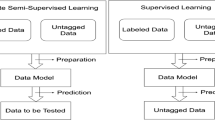Abstract
Sports action monitoring needs to overcome the influence of multiple interference factors and match the monitored movements with standard movements. In order to improve the effect of sports action monitoring, based on the feature similarity algorithm, this paper constructs a sports monitoring model based on the feature similarity model, and proposes a new optimization-driven deep learning framework to solve a series of image enhancement tasks. Moreover, this paper introduces a data-driven deep network to provide a fast descent direction for accelerating the solution, and introduces an error control mechanism inferred by optimization theory to judge the correctness of the network output result and correct it to ensure that the desired target solution can be obtained in the end. In addition, by adopting the idea of optimization-driven deep learning, a task-specific optimization-driven deep learning framework is constructed for complex tasks. Finally, this paper designs experiments to verify the performance of the model. The comparison results show that the model constructed in this paper has certain practical effects.








Similar content being viewed by others
References
Abukhalaf H, Wang J, Zhang S (2015) Outlier detection techniques for localization in wireless sensor networks: a survey. Int J Future Gener Commun Netw 8(6):99–114
Adachi K (2016) Matrix-based introduction to multivariate data analysis. Springer, Singapore
Aggarwal CC (2015) Outlier analysis. Data mining. Springer, Cham. https://doi.org/10.1007/978-3-319-14142-8_8
Bharti S, Pattanaik K, Pandey A (2019) Contextual outlier detection for wireless sensor networks. J Ambient Intell Human Comput 11(4):1511–1530
Biswas S, Das R, Chatterjee P (2018) Energy-efficient connected target coverage in multi-hop wireless sensor networks. In: Bhattacharyya S, Sen S, Dutta M, Biswas P, Chattopadhyay H (eds) Industry interactive innovations in science, engineering and technology, vol 11. Springer, Singapore, pp 411–421
Cai XJ, Hu ZM, Chen JJ (2020a) A many-objective optimization recommendation algorithm based on knowledge mining. Inf Sci 537:148–161
Cai X, Geng S, Wu D, Cai J, Chen J (2020b) A multi-cloud model based many-objective intelligent algorithm for efficient task scheduling in internet of things. IEEE Internet Things J. https://doi.org/10.1109/JIOT.2020.3040019
Cui X, Ma Z (2019) Dynamic heartbeat detection algorithm based on RBFNN. J Eng 20:6426–6428
Cui ZH, Xue F, Cai XJ, Cao Y, Wang GG, Chen JJ (2018) Detection of malicious code variants based on deep learning. IEEE Trans Ind Inform 14(7):3187–3196
da Silva IN, Hernane Spatti D, Andrade Flauzino R, Liboni LHB, dos Reis Alves SF (2017) Radial basis function networks. Artificial neural networks. Springer, Cham, pp 117–138
De Paola A, Gaglio S, Re GL, Milazzo F, Ortolani M (2015) Adaptive distributed outlier detection for WSNs. IEEE Trans Cybern 45:902–913
Du K-L, Swamy MN (2013) Neural networks and statistical learning. Springer, Berlin
Fang W, Wen X, Xu J, Zhu J (2019) CSDA: a novel cluster-based secure data aggregation scheme for WSNs. Cluster Comput 22(3):5233–5244
Garrido-Varo A, Garcia-Olmo J, Fearn T (2019) A note on Mahalanobis and related distance measures in WinISI and The Unscrambler. J Near Infrared Spectrosc 27(4):253–258
Gedik B, Liu L, Philip SY (2007) ASAP: an adaptive sampling approach to data collection in sensor networks. IEEE Trans Parallel Distrib Syst 18(12):1766–1783
Haykin SS (2009) Neural networks and learning machines. Prentice-Hall, Pearson Upper Saddle River
Jadhav NH, Kashid DN, Kulkarni SR (2014) Subset selection in multiple linear regression in the presence of outlier and multicollinearity. Stat Methodol 19:44–59
Khedo K, Doomun R, Aucharuz S (2010) Reada: redundancy elimination for accurate data aggregation in wireless sensor networks. Wirel Sens Netw 2(04):300
Kokoska S, Zwillinger D (2000) CRC standard probability and statistics tables and formulae. Chapman & Hall/CRC, USA
Kuna HD, García-Martinez R, Villatoro FR (2014) Outlier detection in audit logs for application systems. Inf Syst 44:22–33
Li G, Wang Y (2013) Automatic ARIMA modeling-based data aggregation scheme in wireless sensor networks. EURASIP J Wirel Commun Netw 2013:85
Lin H, Bai D, Gao D, Liu Y (2016) Maximum data collection rate routing protocol based on topology control for rechargeable wireless sensor networks. Sensors 16:1201
Liu C, Wu K, Pei J (2007) An energy-efficient data collection framework for wireless sensor networks by exploiting spatiotemporal correlation. IEEE Trans Parallel Distrib Syst 18(7):1010–1023
Author information
Authors and Affiliations
Corresponding author
Additional information
Publisher's Note
Springer Nature remains neutral with regard to jurisdictional claims in published maps and institutional affiliations.
Rights and permissions
About this article
Cite this article
Hu, X., Zong, B. & Pang, B. Simulation of sports action monitoring based on feature similarity model. J Ambient Intell Human Comput (2021). https://doi.org/10.1007/s12652-021-03046-7
Received:
Accepted:
Published:
DOI: https://doi.org/10.1007/s12652-021-03046-7




